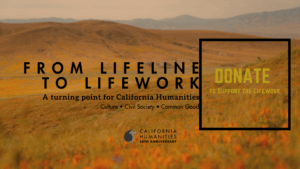Top Photo: Bidhan Roy with WordsUncaged members, James King and Jimmy Gilmer at Los Angeles County Prison, Lancaster. Photo courtesy of Bidhan Roy.
An interview with Dr. Bidhan Chandra Roy, current Vice-Chair of California Humanities’ Board of Directors.
Our “3 Questions” collection of board member interviews continues in September with California Humanities Board Member and Vice-Chair, Dr. Bidhan Chandra Roy, who is Professor of English at California State University, Los Angeles. Born in England and with a Ph.D. from Goldsmiths College, University of London, Bidhan has been an active member of our board since 2019. He is also faculty director of CSULA’s BA program at Lancaster State Prison and California Institute for Women, Chino; it is from this perspective that he created the Words Uncaged program, a nonprofit which uses literature and community engagement to re-humanize men sentenced to life in prison and to change how we think about mass incarceration. Bidhan spoke with us about prison programs and his global perspective on the humanities.
Tell us more about your work with incarcerated populations. Where do the humanities fit in?
My work in California prisons began as a volunteer in 2013 at Los Angeles County Prison, Lancaster. Here I met all these incredible human beings who had been thrown away and forgotten by society, warehoused, and left to die in prison: articulate, thoughtful men, who had so much to offer the world; lights of transformation with a rare wisdom, earned the hard way. At this time, I began a weekly writing workshop at the prison that eventually became the non-profit, WordsUncaged. The goal was to create a platform for the public to share my experience of meeting these men—via the only means we had available to us—their words and artistic voices. The foundational idea has always been that if we could help incarcerated men and women become visible and legible to people, then our current system of mass incarceration—based as it is on fear and invisibility—would become intolerable. California Humanities supported WordsUncaged in these early days and played a role in helping many incarcerated voices reach new audiences.
Pretty quickly after starting WordsUncaged, I worked with Taffany Lim and Jose Gomez at Cal State LA to create the only face-to-face BA in California in 2016: my current job at Cal State LA is serving as the faculty director of this program. This fall we are starting a new BA at California Institution for Women (CIW) women’s prison in Chino.
The humanities remain central to all this work. It is one thing to say that currently in the United States there are over 2 million people in prison; but it is another thing to ask how we get out of this mess. Critiques of mass incarceration are widespread today, but real alternatives to this system are lesser told stories that have yet to be fully imagined and written. Nevertheless, these alternative stories to mass incarceration are everywhere: they are quietly being whispered throughout California prisons and on the streets of Los Angeles, Oakland, San Bernadino, Stockton, Fresno…by incarcerated, and formerly incarcerated, men and women who are imagining themselves as the solutions to the problems that they have been told they are the cause: gangs, drugs, violence, poverty. These are stories that find creativity, love, and freedom in unexpected bodies, spaces, places, and practices. In these ways, I have really come to see the humanities as central to efforts of ending mass incarceration—as a prime mover in this process. But this version of the humanities needs to be practiced rather than consumed, and it needs to be collective, rather than individualized: a with, together, participatory, humanities.

Your education at the University of London, the work you have published on South Asian literary representations, and your current role at CSULA give you a global perspective of both literature and educational approaches. How have your experiences in multiple countries informed your teaching and research?
My earliest memories of England are of growing up in an Indian restaurant in Kent. When I was a little boy, I can remember loving our restaurant and house as spaces through which all kinds of people from around the world passed; but I also remember a deep shame from the racist violence in England throughout the 1970’s and 80’s that made me wish I had a more English sounding name and white skin. If you were a European or American ex-pat in London during this time you were seen as wonderfully exotic and cosmopolitan, but somehow my experience of the global or the cosmopolitan were seen as less-than.
During my academic career, I came to value my own upbringing as a sort of “working class cosmopolitanism” that shaped how I saw the world, how I read literature, and, perhaps most importantly, how I developed a set of values that continue to inform my relationships with others and with the planet: curiosity, openness, empathy, comfort with liminality, and responsibility to reduce suffering for all sentient beings. The gift of living in numerous different countries, as well as in global cities like London and Los Angeles, has reinforced this sense of openness to the world and fostered an ability to empathize and connect with people with whom I share no biographical or ancestral background. This is how I try to approach teaching and research. My hope is to attune my students to the unique perspectives that they bring to texts, encouraging them see their backgrounds and experiences as assets that can create new knowledge and insight into the world. I see the humanities as a space to imagine new futures and worlds, to heal and explore—with the goal of human flourishing, or as classical philosophers put it, eudaimonia. I feel tremendously lucky that I can do this work as a profession and learn from my students at Cal State LA—both on campus and within carceral settings.
What is at the top of your travel list for the coming year or two?
My wife was born in Colombia, so we are planning a post-COVID trip to visit her family in Bogota. We also own an old Dodge van that we travel in extensively throughout California. Despite moving here in 1993, I still am in awe at the beauty of California and love continuing to explore and re-explore the state: to me, California remains one of the most beautiful places on the planet. I never get tired of finding some new road or mountain that I have yet to discover and waking up in the van with a whole new world around me. I may have read too many Jack Kerouac novels as a 15-year-old during dark English winters, but the unique light and landscapes of California continue to cast a spell on me—even after 30 years.






